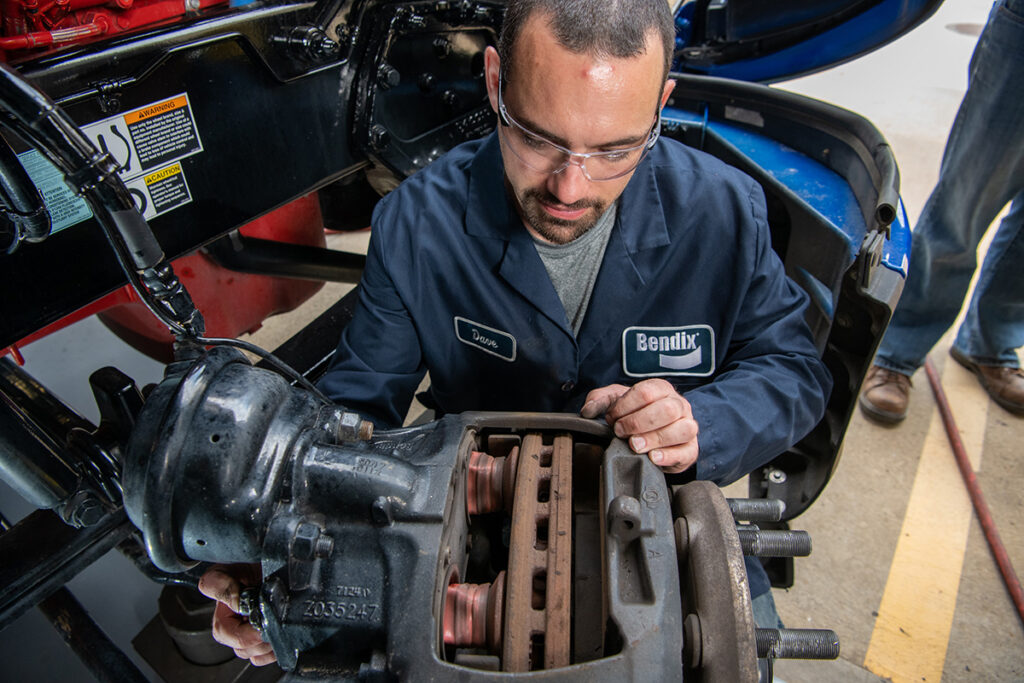Get The Most Out Of Your Air Disc Brake Investment

Keeping air disc brakes in peak operating condition plays an important role in any bus/motorcoach operator’s safety efforts.
By Mark Holley, Director of Marketing and Customer Solutions – Wheel-End, Bendix Commercial Vehicle Systems LLC
Why are bus and motorcoach operators choosing air disc brakes (ADBs) in growing numbers? Because they understand that an investment in ADBs pays off in several ways, both on the road and in the shop, from shorter stopping distances and elimination of brake fade to reduced maintenance time.
Over the past dozen years, adoption and standard positioning of ADBs have escalated, marking a major shift across the North American commercial vehicle industry, including in the transit bus and motorcoach markets. Today, about 15-20% of buses spec air disc brakes, a percentage that increases steadily every year.
ADBs provide distinct advantages over drum brakes — safety, uptime, and return on investment among them. They also support Advanced Driver Assistance Systems (ADAS), such as full stability and collision mitigation. These systems require reliable, consistent stopping power at the wheel-ends to perform at their best. ADBs deliver.
Getting the most out of an investment in ADBs means taking care of them. The good news is that maintaining your brakes is a straightforward matter.
Consider The Friction Couple
Understanding the pairing of the brake pads and rotor — the friction couple — is a useful place to start.
Technically speaking, the friction couple converts the kinetic energy of the spinning rotor into heat energy by forcing the pads against the rotor, slowing the wheel-end. The contact between the pad and rotor creates friction, which generates heat energy that the rotor stores and then dissipates. One reason ADBs don’t experience brake fade is that their design allows for much quicker heat dissipation than drum brakes.
The best friction couples result when rotors and pads are designed and engineered specifically for each other. This is because there are many complex variables that determine how these components will perform when they come together to stop a vehicle, such as the proprietary friction material in a brake pad and the physical design and metallurgy of a rotor.
OEMs can engineer both the rotor and brake pad to optimize torque output — the actual stopping force provided to slow the wheel-end — and wear optimally together. These manufacturers can also design specific pads to wear at a rate with some equivalence to the rotor, which protects rotor life and helps ensure a quality friction couple. The wrong pad, for instance, may last longer but wear out the rotor faster.
The ABCs Of ADB Friction
Choosing replacement pads is a critical part of proper ADB maintenance. The aftermarket provides many friction options, not all of which will meet FMVSS-121 stopping distance requirements in effect at the time of a vehicle’s manufacture. Further, some pads have been shown to increase stopping distances when compared to OEM friction. When replacing ADB pads, it’s recommended to use like-for-like components to maintain the original manufacturer’s braking performance levels.
ADB pad friction has evolved to account for varying fleet factors, including application, tractor/trailer brake combinations, and duty cycle. Frictions are available to meet several wear rate performance needs, including managing high temperatures in applications with repeated, frequent brake usage, such as school buses.
The Environmental Protection Agency’s Copper-Free Brake Initiative Phase 2, which took effect on January 1, 2021, affects brake friction composition as well. The initiative makes it important to pay close attention to replacement friction material compliance.
Know When To Replace Pads
A watchful eye for friction wear is the heart of ADB preventive maintenance. ADBs are lubricated for life and don’t need grease fittings or oil spray, so the focus should be on replacing the pads when they approach the end of life — before they could damage the rotor.
Look for easy-to-use ADB pad wear gauges that simplify the process of measuring the thickness of both rotors and friction. The tool doesn’t require removal of any brake components, and — in addition to the friction thickness measurement — provides a percentage estimate of how much of the brake pad’s life remains. Keep in mind that the minimum allowable friction material thickness is 3.2 mm.
New technologies enable more proactive friction monitoring. For example, air disc brake pad wear sensing technology is available that determines when a pad is nearing its replacement period and provides a signal, via telematics, that fleets can use to proactively schedule maintenance. In addition, the system protects costly ADB components, such as rotors, from being damaged by worn-out pads, since it provides alerts when pads are reaching the point of replacement.
Preventive Maintenance Tips
It’s true that ADBs offer extended service intervals when compared to drum brakes. But don’t be fooled. ADBs should still be checked during every preventive maintenance inspection. This will contribute to the brakes’ longevity, and generally doesn’t require wheel removal. Think of routine checks as an early-warning system for issues that require immediate attention.
Start with a visual check of caliper movement to ensure that it slides freely. Check the rotor, too, with an eye out for surface cracks beyond allowable limits. An inspection mirror provides the best view of the rotor from outside to inside. The mirror is also useful for checking pad wear.
Next, be sure to examine the mounting hardware of calipers and air chambers: In a roadside inspection, loose mounting bolts will get a brake placed out-of-service. Ensure the guide pin covers are in place, and assess for proper rotor/pad running clearances.
A more thorough check should be conducted with the wheel off if these inspections raise any concerns, such as large rotor cracks, a caliper that doesn’t move freely, or pads wearing unequally from the inboard pad to the outboard pad. If this is the case, take the opportunity to also look for damaged tappets and guide pin boots.
Keeping ADBs in peak operating condition for as long as possible plays an important role in any bus or motorcoach operator’s safety efforts. The right maintenance practices and careful selection of replacement parts help protect your investment in air disc brakes and help contribute to safer roads for everyone.
Bendix Commercial Vehicle Systems, a member of Knorr-Bremse, develops and supplies leading-edge active safety technologies, energy management solutions, and air brake charging and control systems and components under the Bendix® brand name for medium- and heavy-duty trucks, tractors, trailers, buses, and other commercial vehicles throughout North America. An industry pioneer, employing more than 4,400 people, Bendix — and its wholly owned subsidiary, R.H. Sheppard Co., Inc. — is driven to deliver the best solutions for improved vehicle safety, performance, and overall operating cost. Contact us at 1-800-AIR-BRAKE (1-800-247-2725) or visit bendix.com. Stay connected and informed through Bendix expert podcasts, blog posts, videos, and other resources at knowledge-dock.com. Follow Bendix on Twitter at twitter.com/Bendix_CVS. Log on and learn from the Bendix experts at brake-school.com. And to learn more about career opportunities at Bendix, visit bendix.com/careers.
Mark Holley is Director of Marketing and Customer Solutions – Wheel-End, Bendix Commercial Vehicle Systems LLC. An accomplished professional with a broad range of practical business experience, Holley’s career spans over 25 years in the commercial vehicle industry. He has held numerous key roles in operations, product marketing, and product management in the OEM and aftermarket segments.

